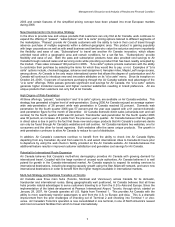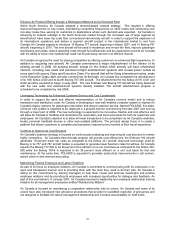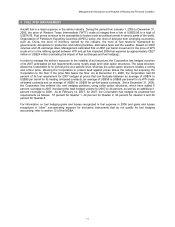Air Canada 2006 Annual Report Download - page 19
Download and view the complete annual report
Please find page 19 of the 2006 Air Canada annual report below. You can navigate through the pages in the report by either clicking on the pages listed below, or by using the keyword search tool below to find specific information within the annual report.Salaries and wages expense totaled $373 million in Quarter 4 2006, an increase of $10 million or 3 percent from
Quarter 4 2005 in part due to higher average salaries partly offset by a decrease of 3 percent or an average of
769 FTE employees.
A workforce reduction plan was announced in February 2006 to reduce the number of non-unionized employees
by 20 percent. A charge of $28 million was recorded in Quarter 1 2006 relating to this program. During Quarter
4 2006, the estimated cost of this plan was revised due to the favourable impact of attrition and other factors
which reduced the cost of achieving the target. As a result, the Air Canada Services segment recorded a
reduction of $8 million in Quarter 4 2006 to the special charge for labour restructuring.
Employee benefits expense amounted to $70 million in Quarter 4 2006, a decrease of $30 million or 30 percent
over Quarter 4 2005. Included in Quarter 4 2006 were favourable adjustments of $6 million pertaining to
pension expense for the full year 2006 as a result of a revised pension expense estimate and $8 million related
to an updated evaluation of workers’ compensation liability. Included in Quarter 4 2005 was an unfavourable
adjustment of $5 million relating to an updated actuarial evaluation of workers’ compensation liability. Excluding
these adjustments, the remaining $11 million decrease in employee benefits expenses was mainly due to a
decline in post-employment benefits partly offset by higher pension expense which reflected a lower discount
rate applied to pension obligations.
Fuel expense increased $6 million or 1 percent in Quarter 4 2006 due to a volume-related increase of $23
million bringing the total year 2006 fuel expense increase to $347 million or 16 percent. In Quarter 4 2006, a
stronger Canadian dollar versus the US dollar reduced fuel expense by $24 million compared with Quarter 4
2005 and a lower average base fuel price decreased it by a further $22 million. These decreases were partly
offset by an increased realized hedging loss of $29 million. The unit cost of fuel in Quarter 4 2006 was reduced
by 3 percent when compared to Quarter 4 2005. Fuel expense for MD-11 freighter operations declined $6
million mainly on reduced flying.
Ownership costs, comprised of aircraft rent, depreciation, amortization and obsolescence expenses, increased
$14 million in Quarter 4 2006. Increases in ownership costs included a change in assumptions relating to the
residual value of certain aircraft and the addition of 16 Embraer aircraft to Air Canada’s operating fleet.
Decreases in ownership costs included the impact of aircraft returns and lease terminations, the transfer of 10
CRJ-100 aircraft to Jazz which shifts the ownership cost to the capacity purchase expense category, the
reduction of one MD-11 freighter aircraft and the impact of a stronger Canadian dollar on aircraft rent.
Airport and navigation fees increased $10 million or 5 percent in Quarter 4 2006, mainly due to an increase of 7
percent in aircraft departures and increased rates for landing and general terminal fees, primarily at Toronto’s
Pearson International Airport. At Pearson, general terminal charges rose 9 percent per seat for domestic and
international arrivals. These increases were partly offset by a rate reduction for navigation fees in Canada and
favourable foreign exchange for international navigation fees.
Aircraft maintenance, materials and supplies increased $25 million or 14 percent in Quarter 4 2006 largely due
to increased airframe maintenance activity for Boeing 767 aircraft and, to a lesser extent, Airbus A320 aircraft,
due to cycle timing. Other increases included increased engine maintenance activity for Airbus A320 and A340
aircraft and expenses related to satisfying minimum return conditions on short-term leases and future return to
lessor expenses. These increases were partly offset by an overall reduction in volume of aircraft components.
Food, beverage and supplies expense decreased $2 million or 3 percent versus Quarter 4 2005 on a passenger
traffic increase of 5 percent. The volume-related increase was more than offset by cost reduction initiatives and
the impact of new catering programs, including the buy-on-board program.
For Quarter 4 2006, capacity fees paid to Jazz, pursuant to the Jazz CPA, amounted to $224 million compared
to capacity fees paid to Jazz of $194 million in Quarter 4 2005, pursuant to the Initial Jazz CPA. The increase
of 15 percent in Quarter 4 2006 was mainly driven by a growth of 12 covered aircraft in Jazz’s operating fleet,
resulting in a 21 percent increase in block hours over Quarter 4 2005. ASM capacity for flights operated by
Jazz increased 26 percent over Quarter 4 2005.
Non-operating expense amounted to $52 million in Quarter 4 2006 compared to non-operating expense of $86
million for Quarter 4 2005. For Quarter 4 2006, net interest expense decreased $12 million. The increase in
interest expense, largely driven by the financing of additional aircraft, was more than offset by a higher amount
of capitalized interest relating to the acquisition of the Boeing 777 and 787 aircraft and growth in interest income
19
Management's Discussion and Analysis of Results and Financial Condition
























